Ninh Binh, Vietnam offers a breathtaking blend of natural landscapes, ancient temples, and captivating boat trips, making it a paradise for photographers; SIXT.VN is here to guide you through the best spots to capture its beauty. With options ranging from serene boat rides to historical sites, Ninh Binh promises a visual feast, and we are here to help you discover Ninh Binh photo spots that will take your breath away.
1. What Makes Ninh Binh a Photographer’s Paradise?
Ninh Binh is a stunning location for photographers thanks to its gorgeous natural beauty. The area is known for its limestone karsts, winding rivers, and verdant rice paddies, which provide an abundance of chances for stunning photos. The unique combination of history and culture gives an appealing setting for photographers. According to the Vietnam National Administration of Tourism, Ninh Binh has seen a steady increase in tourist arrivals, highlighting its appeal as a must-visit location for both amateur and professional photographers.
1.1. Landscape Photography Opportunities
Ninh Binh’s landscapes are a dream for any photographer. The iconic limestone karsts rising from the rice paddies create a surreal and captivating scene. The waterways wind through these formations, providing reflective surfaces that enhance the beauty of the surroundings.
- Tam Coc: Known as “Ha Long Bay on Land,” Tam Coc offers boat tours that meander through three natural caves, providing incredible photo opportunities of the surrounding landscape. The best time to visit is during the rice harvest season when the paddies turn golden yellow.
- Trang An: A UNESCO World Heritage site, Trang An offers a more extensive network of waterways and caves. The boat tours here are longer and less crowded than Tam Coc, providing a more serene experience. The complex includes various temples and pagodas nestled among the karsts.
- Mua Cave: For a panoramic view of Ninh Binh, climb to the top of Mua Cave. The viewpoint offers stunning vistas of Tam Coc, with the Ngo Dong River winding through the rice fields. This is an especially popular spot for sunrise and sunset photography.
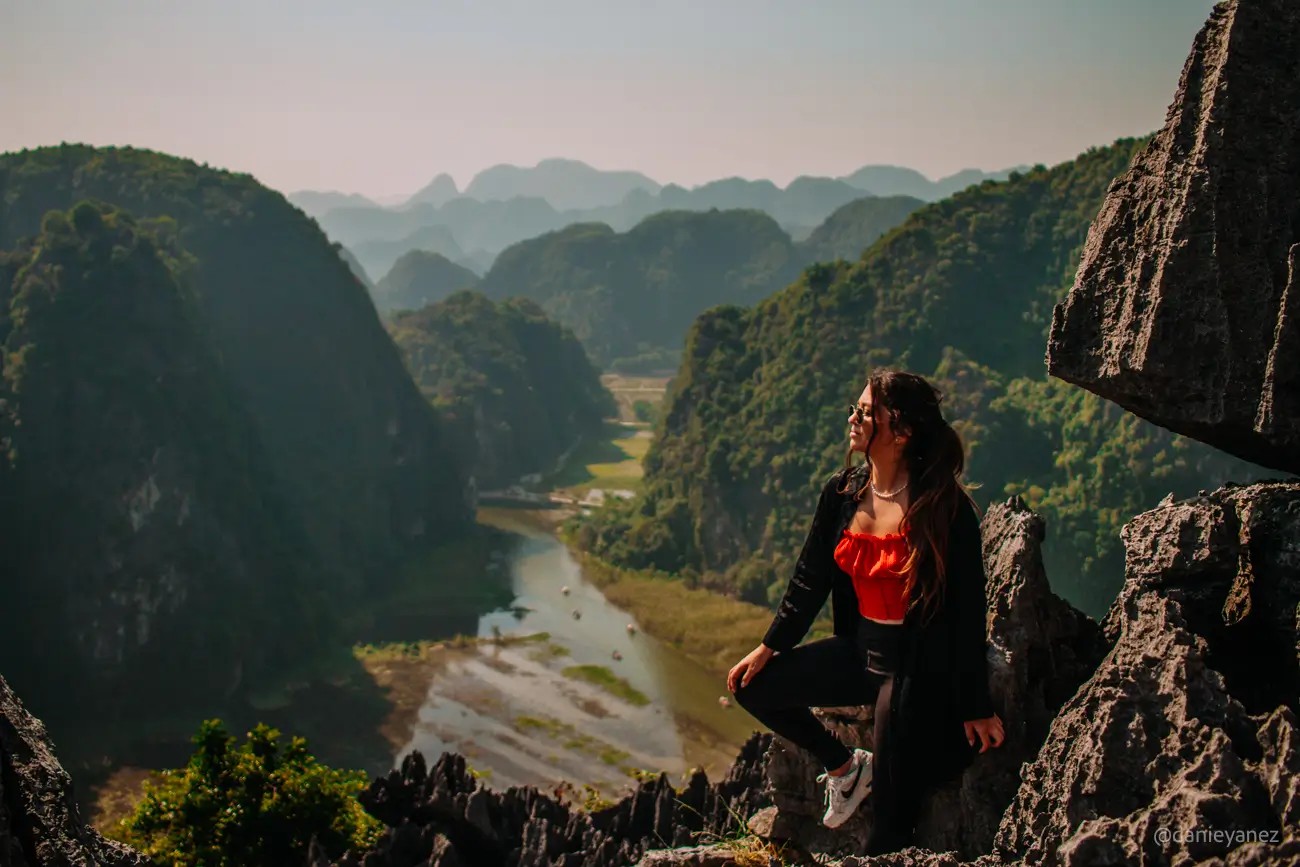 Panorama of Ninh Binh from Mua Cave
Panorama of Ninh Binh from Mua Cave
1.2. Cultural and Temple Photography
Ninh Binh is rich in history and culture, offering numerous opportunities for capturing stunning images of ancient temples and historical sites.
- Bai Dinh Pagoda: This is one of the largest Buddhist complexes in Southeast Asia, featuring impressive architecture, intricate carvings, and numerous Buddha statues. The pagoda complex offers a blend of natural beauty and human artistry.
- Hoa Lu Ancient Capital: As the former capital of Vietnam, Hoa Lu is home to ancient temples and historical relics. The temples of King Dinh and King Le are particularly noteworthy, featuring traditional Vietnamese architecture and intricate details.
- Thai Vi Temple: Situated in Tam Coc, Thai Vi Temple is a serene and picturesque temple surrounded by rice fields and limestone karsts. The temple’s tranquil setting makes it an ideal spot for contemplative photography.
1.3. Boat Trip Photography
Boat trips in Ninh Binh are a must for any photographer. They provide a unique perspective on the landscape, allowing you to capture the beauty of the region from the water.
- Tam Coc Boat Trip: This iconic boat trip takes you through three caves, with local rowers often using their feet to propel the boats. The reflections on the water and the stunning rock formations create magical photo opportunities.
- Trang An Boat Trip: The Trang An boat trip offers a longer and more diverse experience, with multiple routes to choose from. The trip includes visits to temples and caves, providing a mix of natural and cultural subjects.
- Van Long Nature Reserve: While less known than Tam Coc and Trang An, Van Long offers a peaceful boat trip through a nature reserve, where you can spot various bird species and enjoy the tranquil scenery.
2. What Are The Must-Visit Landscape Photography Spots in Ninh Binh?
Ninh Binh’s stunning landscapes provide endless opportunities for photographers; the key is knowing where to find the most captivating views. Ninh Binh offers a lot of beauty that can be found nowhere else in the world. These are the must-visit landscape photography spots in Ninh Binh:
2.1. Tam Coc: “Three Caves”
Tam Coc, meaning “Three Caves,” is one of the most iconic destinations in Ninh Binh. According to TripAdvisor, it is consistently ranked among the top attractions in the region, drawing visitors with its stunning natural beauty and serene boat tours.
- Best Time to Visit: The rice harvest season (May-June and September-October) is the ideal time to visit Tam Coc. During these months, the rice paddies turn golden yellow, creating a vibrant and picturesque landscape.
- Photography Tips:
- Golden Hour: Capture the beauty of Tam Coc during the golden hour (early morning or late afternoon) when the light is soft and warm.
- Reflections: Use the calm waters of the Ngo Dong River to capture stunning reflections of the limestone karsts and rice paddies.
- Wide-Angle Lens: A wide-angle lens is essential for capturing the expansive landscapes of Tam Coc.
- Candid Shots: Focus on capturing candid moments of the local rowers and the daily life along the river.
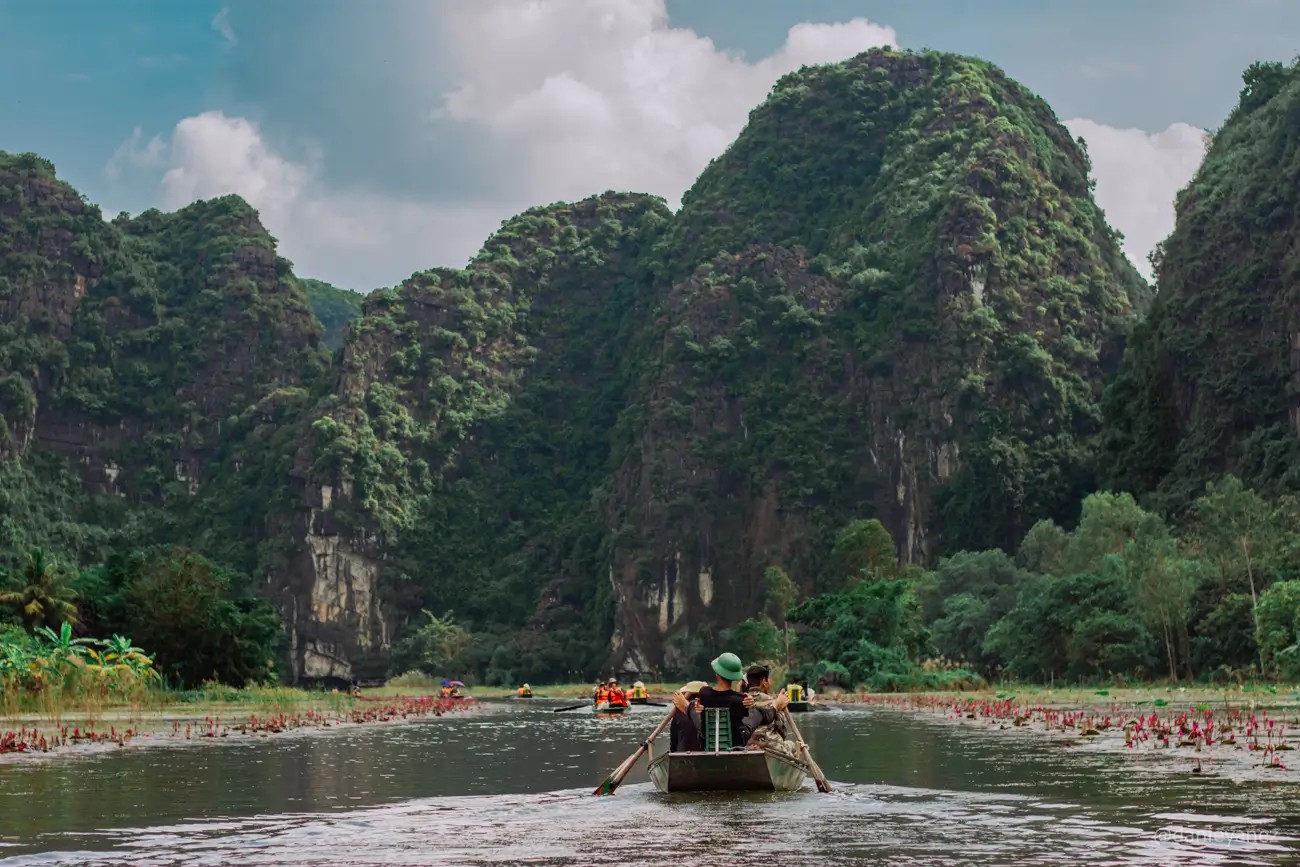 Tam Coc boat ride in Ninh Binh Vietnam
Tam Coc boat ride in Ninh Binh Vietnam
2.2. Trang An: A UNESCO World Heritage Site
Trang An Landscape Complex, a UNESCO World Heritage site, offers a more extensive and serene experience compared to Tam Coc. The complex includes a network of waterways, caves, and temples, providing a diverse range of photographic subjects.
- Best Time to Visit: The dry season (November to April) is the best time to visit Trang An. The weather is pleasant, and the water levels are ideal for boat tours.
- Photography Tips:
- Explore Different Routes: Trang An offers multiple boat routes, each with its unique attractions. Explore different routes to capture a variety of landscapes and temples.
- Cave Photography: Bring a tripod and use long exposure techniques to capture the beauty of the caves.
- Temple Visits: Capture the intricate details of the temples and pagodas nestled among the karsts.
- Panoramic Views: Look for opportunities to capture panoramic views of the Trang An complex from elevated viewpoints.
2.3. Mua Cave: Panoramic Views
Mua Cave, also known as “Dancing Cave,” offers the best panoramic views of Ninh Binh. Climbing to the top of the cave provides stunning vistas of Tam Coc and the surrounding landscapes.
- Best Time to Visit: Sunrise and sunset are the best times to visit Mua Cave. The soft light during these hours enhances the beauty of the landscape and provides perfect conditions for photography.
- Photography Tips:
- Wide-Angle Lens: A wide-angle lens is essential for capturing the panoramic views from the top of Mua Cave.
- Composition: Pay attention to composition and use leading lines to draw the viewer’s eye into the scene.
- Silhouettes: Capture silhouettes of the dragon statue and other landmarks against the setting sun.
- Patience: Be patient and wait for the perfect light to capture the most stunning images.
3. Where Can You Find The Most Photogenic Temples in Ninh Binh?
Ninh Binh is home to several ancient temples that offer unique photographic opportunities; capturing their beauty requires understanding their history and architectural details. Each temple provides its own special features. The most photogenic temples in Ninh Binh are listed here:
3.1. Bai Dinh Pagoda: A Grand Buddhist Complex
Bai Dinh Pagoda is one of the largest Buddhist complexes in Southeast Asia, featuring impressive architecture, intricate carvings, and numerous Buddha statues. According to the Vietnam Buddhist Sangha, the pagoda is a significant pilgrimage site for Buddhists from around the world.
- Best Time to Visit: Early morning is the best time to visit Bai Dinh Pagoda. The crowds are smaller, and the light is ideal for capturing the beauty of the complex.
- Photography Tips:
- Architectural Details: Focus on capturing the intricate details of the pagoda’s architecture, including the carvings, statues, and roofs.
- Wide-Angle Lens: A wide-angle lens is essential for capturing the grandeur of the complex.
- Religious Significance: Be respectful of the religious significance of the pagoda and avoid disturbing the worshippers.
- Golden Hour: Capture the beauty of the pagoda during the golden hour when the light is soft and warm.
3.2. Hoa Lu Ancient Capital: Historical Relics
Hoa Lu was the ancient capital of Vietnam during the 10th and 11th centuries. Today, it is home to ancient temples and historical relics, offering a glimpse into Vietnam’s rich history.
- Best Time to Visit: The dry season (November to April) is the best time to visit Hoa Lu. The weather is pleasant, and the crowds are smaller than during the peak season.
- Photography Tips:
- Historical Context: Learn about the history of Hoa Lu before your visit to better understand the significance of the temples and relics.
- Traditional Architecture: Focus on capturing the traditional Vietnamese architecture of the temples.
- Details: Pay attention to the details, such as the carvings, statues, and inscriptions.
- Natural Surroundings: Capture the beauty of the natural surroundings, including the gardens and landscapes.
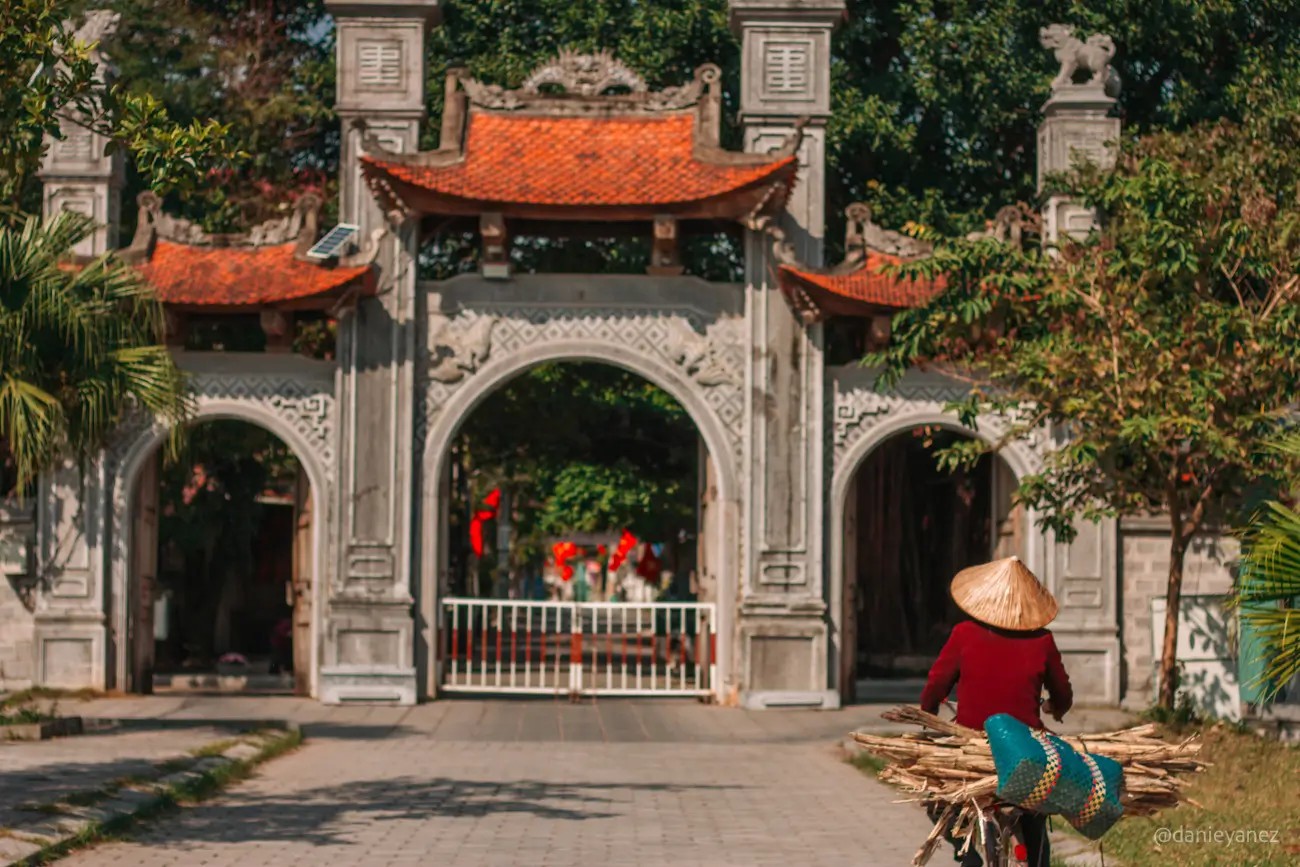 Hoa Lu, Vietnam
Hoa Lu, Vietnam
3.3. Thai Vi Temple: A Serene Setting
Thai Vi Temple is a serene and picturesque temple situated in Tam Coc. Surrounded by rice fields and limestone karsts, the temple offers a tranquil setting for contemplative photography.
- Best Time to Visit: Early morning or late afternoon is the best time to visit Thai Vi Temple. The light is soft, and the crowds are smaller than during the middle of the day.
- Photography Tips:
- Tranquil Atmosphere: Capture the tranquil atmosphere of the temple.
- Natural Surroundings: Use the surrounding rice fields and limestone karsts to frame your shots.
- Reflections: Capture reflections of the temple in the nearby ponds and waterways.
- Candid Moments: Focus on capturing candid moments of the monks and worshippers at the temple.
4. Which Boat Trips Offer the Best Photography Opportunities in Ninh Binh?
Boat trips in Ninh Binh offer a unique perspective on the region’s stunning landscapes. The best boat trips combine scenic beauty with cultural experiences, providing photographers with a wealth of subjects to capture. These boat trips offer the best photography options in Ninh Binh:
4.1. Tam Coc Boat Trip: Through Three Caves
The Tam Coc boat trip is one of the most popular attractions in Ninh Binh, taking visitors through three natural caves along the Ngo Dong River.
- Best Time to Visit: The rice harvest season (May-June and September-October) is the best time to visit Tam Coc. The golden rice paddies create a stunning backdrop for photography.
- Photography Tips:
- Golden Hour: Capture the beauty of Tam Coc during the golden hour when the light is soft and warm.
- Reflections: Use the calm waters of the Ngo Dong River to capture stunning reflections of the limestone karsts and rice paddies.
- Local Rowers: Focus on capturing candid moments of the local rowers, who often use their feet to propel the boats.
- Caves: Use a tripod and long exposure techniques to capture the beauty of the caves.
4.2. Trang An Boat Trip: A Diverse Experience
The Trang An boat trip offers a longer and more diverse experience compared to Tam Coc. The trip includes visits to temples and caves, providing a mix of natural and cultural subjects.
- Best Time to Visit: The dry season (November to April) is the best time to visit Trang An. The weather is pleasant, and the water levels are ideal for boat tours.
- Photography Tips:
- Explore Different Routes: Trang An offers multiple boat routes, each with its unique attractions. Explore different routes to capture a variety of landscapes and temples.
- Cave Photography: Bring a tripod and use long exposure techniques to capture the beauty of the caves.
- Temple Visits: Capture the intricate details of the temples and pagodas nestled among the karsts.
- Panoramic Views: Look for opportunities to capture panoramic views of the Trang An complex from the water.
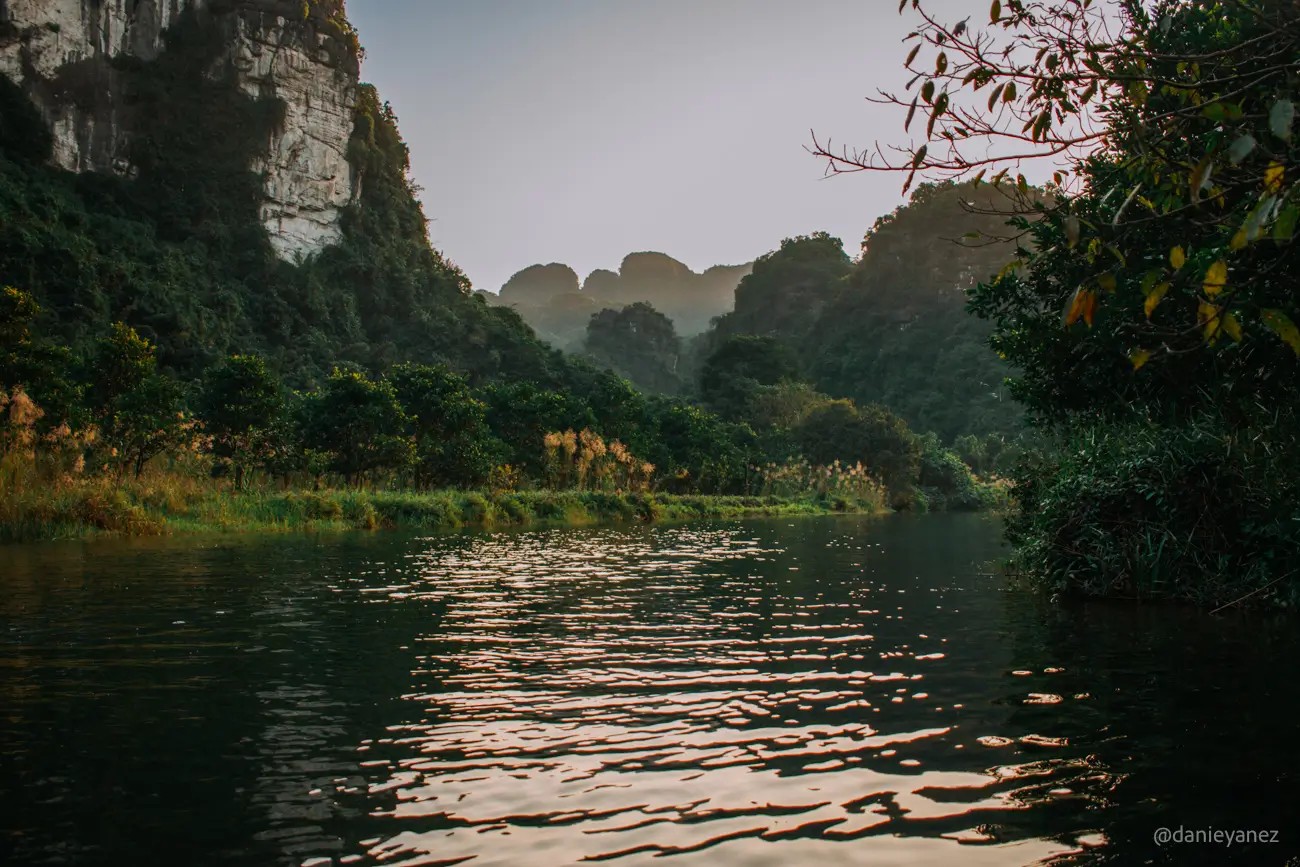 Vietnam ninh binh rural area, trang an boat ride views
Vietnam ninh binh rural area, trang an boat ride views
4.3. Van Long Nature Reserve: Tranquil Scenery
Van Long Nature Reserve offers a peaceful boat trip through a protected wetland area. The reserve is home to a variety of bird species and offers tranquil scenery.
- Best Time to Visit: The dry season (November to April) is the best time to visit Van Long. The weather is pleasant, and the birdlife is abundant.
- Photography Tips:
- Bird Photography: Bring a telephoto lens to capture the various bird species that inhabit the reserve.
- Tranquil Scenery: Focus on capturing the tranquil scenery of the wetlands.
- Reflections: Use the calm waters of the reserve to capture stunning reflections of the surrounding landscapes.
- Patience: Be patient and wait for the perfect moment to capture the birds in flight.
5. What Are Some Lesser-Known Photography Spots in Ninh Binh?
While Tam Coc, Trang An, and Mua Cave are popular, Ninh Binh has many hidden gems waiting to be discovered by adventurous photographers; these locations provide a more intimate and authentic experience. Here are some hidden photographic gems in Ninh Binh:
5.1. Thung Nham Bird Valley: A Natural Park
Thung Nham Bird Valley is a natural park designed to attract tourists, but it offers some unique photo opportunities.
- Best Time to Visit: Late afternoon is the best time to visit Thung Nham Bird Valley. This is when the birds return to the valley to roost.
- Photography Tips:
- Bird Photography: Take the boat ride to see the birds.
- Designed Environments: Appreciate the park’s artificial features.
- Sunset: Stay to capture sunset views of the valley.
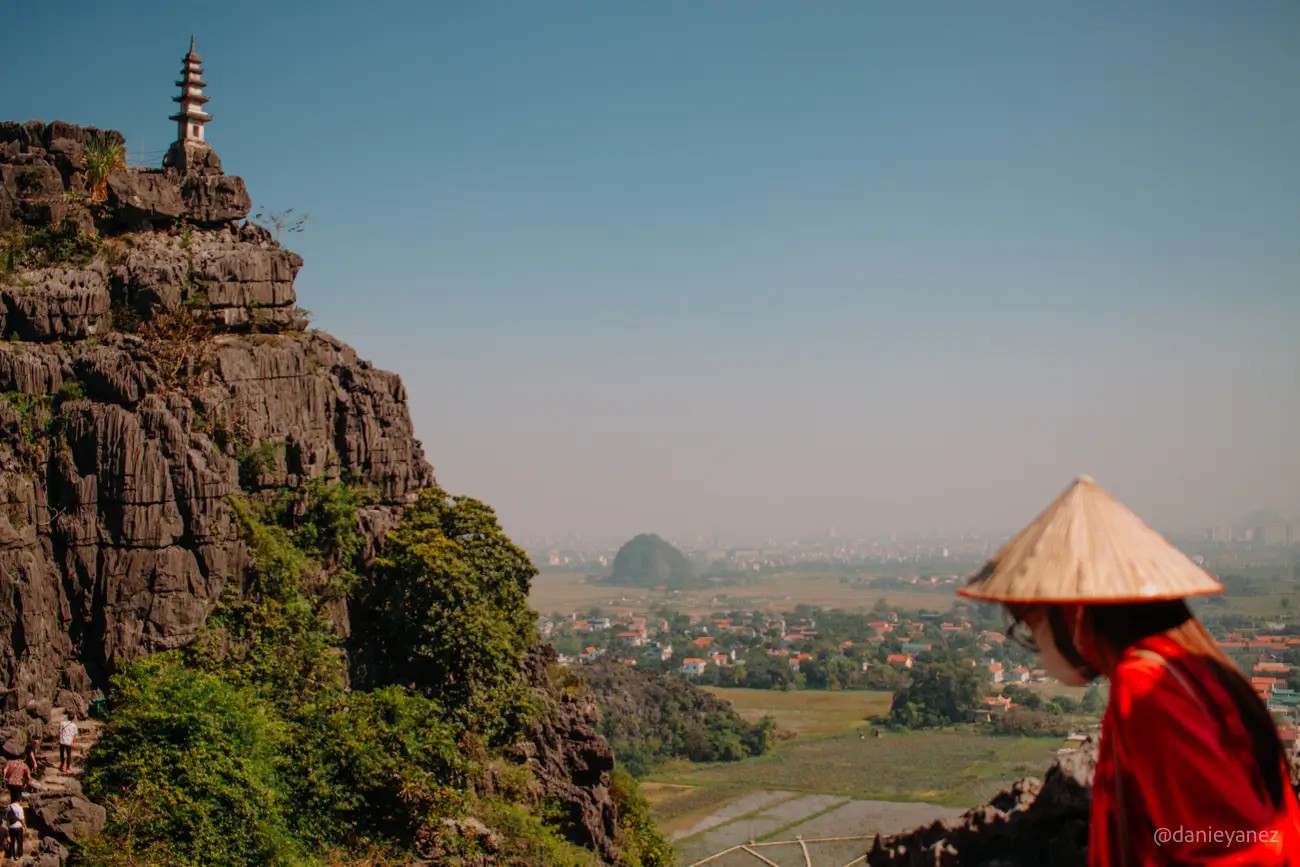 Thung Nham Bird Valley
Thung Nham Bird Valley
5.2. Kenh Ga Floating Village: A Glimpse into Local Life
Kenh Ga is a floating village where locals live in houses on the river. It offers a glimpse into a unique way of life.
- Best Time to Visit: Early morning or late afternoon is best for good light.
- Photography Tips:
- Hire a Boat: To explore, hire a local boat.
- Capture Daily Life: Photograph the daily activities of the villagers.
- Respect Privacy: Be respectful and ask before photographing people.
5.3. Phat Diem Cathedral: A Unique Blend of Architecture
Phat Diem Cathedral is a unique blend of Vietnamese and European architectural styles.
- Best Time to Visit: Weekdays are less crowded.
- Photography Tips:
- Architectural Details: Focus on the cathedral’s unique design elements.
- Wide-Angle Lens: Use a wide-angle lens for the exterior.
- Interior Shots: Capture the stained glass and religious art.
6. How Can You Capture Stunning Sunset and Sunrise Photos in Ninh Binh?
Sunset and sunrise in Ninh Binh offer magical opportunities for photographers. Understanding the best locations and techniques can help you capture stunning images. To get the best sunrise and sunset images from Ninh Binh, follow these tips:
6.1. Best Locations for Sunset and Sunrise
- Mua Cave: Offers panoramic views.
- Tam Coc: Provides reflective waters.
- Trang An: Serene landscapes.
6.2. Photography Techniques
- Golden Hour: Use the golden hour for warm light.
- Composition: Use leading lines.
- Silhouettes: Capture silhouettes.
- HDR: Use HDR to balance exposure.
6.3. Equipment Recommendations
- Tripod: Essential for sharp images.
- Wide-Angle Lens: Captures expansive scenes.
- Telephoto Lens: Useful for distant details.
- Filters: ND filters for balanced exposure.
7. What Equipment Should You Bring for Photography in Ninh Binh?
Having the right equipment is crucial for capturing the best photos in Ninh Binh; depending on your style and focus, different gear can enhance your experience. These are essential pieces of equipment to bring for photographing Ninh Binh:
7.1. Camera and Lenses
- Camera Body: A DSLR or mirrorless camera.
- Wide-Angle Lens: For landscapes.
- Telephoto Lens: For wildlife and details.
- Standard Zoom Lens: A versatile option.
7.2. Accessories
- Tripod: For stable shots.
- Filters: ND and polarizing filters.
- Extra Batteries and Memory Cards: Ensure you don’t run out of power or space.
- Camera Bag: To protect your gear.
- Rain Cover: To protect from the elements.
7.3. Other Useful Items
- Cleaning Kit: To keep your lenses clean.
- Remote Shutter Release: To avoid camera shake.
- Headlamp: For navigating in low light.
- Comfortable Shoes: For hiking and exploring.
8. What Are Some Tips for Photographing Local People and Culture in Ninh Binh?
Photographing the local people and culture of Ninh Binh can add depth and authenticity to your images; however, it’s essential to approach this with respect and sensitivity. The tips for respectfully capturing the local people and culture are:
8.1. Seek Permission
- Always Ask: Before taking someone’s photo, ask for permission.
- Learn Basic Phrases: Knowing a few phrases in Vietnamese can help.
- Respect “No”: If someone declines, respect their wishes.
8.2. Be Respectful
- Dress Appropriately: Dress modestly when visiting temples and religious sites.
- Avoid Disrupting: Be mindful of local customs and avoid disrupting ceremonies or daily activities.
- Be Observant: Pay attention to the environment and be respectful of local traditions.
8.3. Engage with Locals
- Smile: A smile can go a long way in building rapport.
- Show Interest: Show genuine interest in their lives and culture.
- Share Photos: If possible, share the photos you take with the people you photograph.
9. What Are the Best Ways to Get Around Ninh Binh for Photography?
Getting around Ninh Binh efficiently is key to maximizing your photography opportunities; different modes of transportation offer unique advantages. These are the best ways to get around Ninh Binh for photography:
9.1. Motorbike
- Pros: Flexible, quick, and allows access to remote areas.
- Cons: Can be dangerous, requires a valid license, and some experience.
9.2. Bicycle
- Pros: Eco-friendly, healthy, and allows you to explore at a leisurely pace.
- Cons: Limited range, can be tiring in the heat, and not suitable for long distances.
9.3. Car or Taxi
- Pros: Comfortable, safe, and ideal for covering long distances.
- Cons: More expensive, less flexible, and limited access to narrow roads.
9.4. Boat
- Pros: Offers unique perspectives, essential for exploring Tam Coc and Trang An.
- Cons: Dependent on weather conditions and can be crowded.
10. What Are Some Common Mistakes to Avoid When Photographing in Ninh Binh?
Even experienced photographers can make mistakes; being aware of these common pitfalls can help you avoid them and capture better images. To make sure you take the best images possible, avoid the following mistakes when photographing in Ninh Binh:
10.1. Not Planning Ahead
- Research: Lack of research.
- Timing: Not checking.
- Weather: Ignoring the weather.
10.2. Ignoring Composition
- Rule of Thirds: Forgetting composition.
- Leading Lines: Neglecting lines.
- Foreground: Ignoring foreground.
10.3. Not Being Respectful
- Permission: Ignoring permission.
- Customs: Disregarding customs.
- Intrusion: Intruding on events.
10.4. Technical Errors
- Exposure: Incorrect exposure.
- Focus: Poor focus.
- Stability: Unstable camera.
Ninh Binh’s landscapes, temples, and boat trips offer a wealth of photographic opportunities, and SIXT.VN is ready to help you experience them all. By following these tips and planning your trip carefully, you can capture stunning images of this beautiful region. Let SIXT.VN handle your transportation, accommodation, and tour arrangements so you can focus on what matters most: capturing the perfect shot.
Ready to explore the photogenic spots of Ninh Binh? Visit SIXT.VN today to book your perfect trip! Our services include airport transfers, hotel bookings, and guided tours, ensuring a seamless and unforgettable photography adventure. Contact us at +84 986 244 358 or visit our office at 260 Cau Giay, Hanoi, Vietnam.
Frequently Asked Questions (FAQs)
1. What is the best time of year to visit Ninh Binh for photography?
The best time to visit Ninh Binh for photography is during the dry season, which runs from November to April. The weather is generally pleasant, with clear skies and minimal rainfall, making it ideal for outdoor activities and photography.
2. What are the must-visit photography spots in Ninh Binh?
Some of the must-visit photography spots in Ninh Binh include Tam Coc, Trang An, Mua Cave, Bai Dinh Pagoda, and Hoa Lu Ancient Capital. Each location offers unique landscapes, cultural sites, and photo opportunities.
3. What type of equipment should I bring for photography in Ninh Binh?
Essential equipment for photography in Ninh Binh includes a DSLR or mirrorless camera, a wide-angle lens for landscapes, a telephoto lens for wildlife, a tripod for stable shots, and filters to enhance your images.
4. How can I capture the best sunset and sunrise photos in Ninh Binh?
To capture the best sunset and sunrise photos in Ninh Binh, visit locations like Mua Cave or Tam Coc during the golden hour, use a tripod for stability, and experiment with different compositions and settings.
5. Are there any cultural considerations when photographing in Ninh Binh?
Yes, it’s essential to be respectful of local customs and traditions when photographing in Ninh Binh. Always ask for permission before taking someone’s photo, dress modestly when visiting temples, and avoid disrupting ceremonies or daily activities.
6. What are the best ways to get around Ninh Binh for photography?
The best ways to get around Ninh Binh for photography include renting a motorbike for flexibility, hiring a car or taxi for comfort, or taking a boat to explore Tam Coc and Trang An.
7. What are some common mistakes to avoid when photographing in Ninh Binh?
Some common mistakes to avoid when photographing in Ninh Binh include not planning ahead, ignoring composition, not being respectful of local culture, and making technical errors with your camera settings.
8. Can I hire a local guide for photography tours in Ninh Binh?
Yes, you can hire local guides for photography tours in Ninh Binh. These guides can provide valuable insights into the best locations, cultural context, and techniques for capturing stunning images. SIXT.VN offers guided tours tailored to your interests and skill level.
9. How can SIXT.VN help with my photography trip to Ninh Binh?
SIXT.VN offers a range of services to enhance your photography trip to Ninh Binh, including airport transfers, hotel bookings, transportation rentals, and guided tours. We ensure a seamless and unforgettable experience, allowing you to focus on capturing the perfect shots.
10. What should I do if I encounter language barriers while traveling in Ninh Binh?
If you encounter language barriers while traveling in Ninh Binh, try learning a few basic Vietnamese phrases, use translation apps on your smartphone, or hire a local guide who can assist with communication. SIXT.VN’s services also include assistance with translation and communication to ensure a smooth travel experience.



